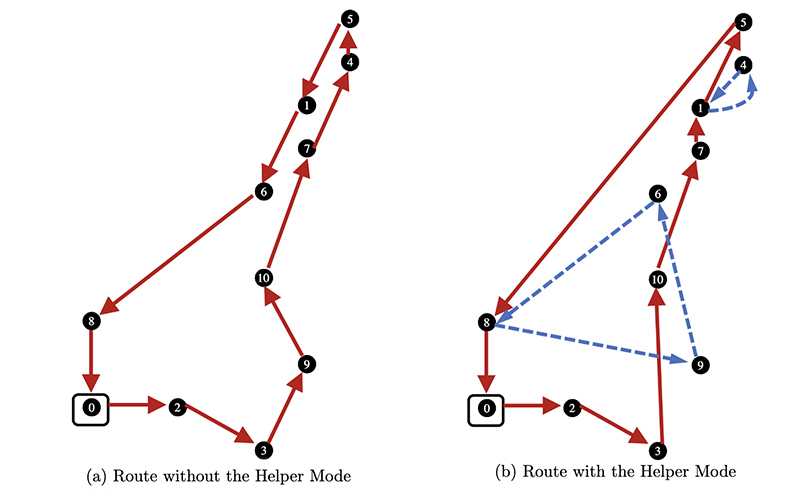
|
 |
An illustration of the Driver-Aide Problem. Fig. 1 from the paper. |
|
ISR alum Rui Zhang (BMGT PhD 2016) and his PhD advisor, Professor S. “Raghu” Raghavan (BMGT/ISR), have produced new work on the best way for logistics network companies to handle last-mile deliveries.
Zhang is an assistant professor in the Leeds School of Business at the University of Colorado.
Last-mile delivery is a critical component of logistics networks, accounting for approximately 30-35% of costs. Logistics companies are under significant pressure to contain these costs while maintaining service and delivery commitments as delivery volumes have increased and truck route times have become longer. To address this issue, many logistics companies, including FedEx and UPS, sometimes use an “aide,” a second person in the truck, to assist with deliveries.
Aides can assist the driver in two ways. As a “jumper,” the aide works with the driver in preparing and delivering packages, reducing the service time at a given stop. As a “helper,” the aide independently works at a location delivering packages, while the driver leaves to deliver packages at other locations and then returns.
Given a set of delivery locations, travel times, service times, and savings from having an aide, the operations research “Driver-Aide Problem” has the goal of determining both an optimal delivery route and the most effective way to use the aide to minimize total delivery time.
In their research paper, The Driver-Aide Problem: Coordinated Logistics for Last-Mile Delivery, Zhang and Raghavan model this problem as an integer program with an exponential number of variables and an exponential number of constraints, and propose a “branch-cut-and-price” approach for solving it. Computational experiments in their research are based on simulated instances built on real-world data provided by an industrial partner.
Zhang and Raghavan conduct an economic analysis that considers the tradeoffs involved in employing a driver-aide system, and provide a high-level understanding of when it is most beneficial to use one. Roughly, delivery routes with greater than 50% of the time devoted to delivery (as opposed to driving) are the ones that provide the greatest benefit. Further, these routes are characterized by a high density of delivery locations.
Should the aide be used as a jumper or a helper? The researchers found there seems to be greater use of the helper mode when the average vehicle speed is somewhat higher, as it allows the driver to simultaneously perform one or more deliveries and return to the aide in about the same time it takes the aide to do his/her delivery.
The results characterize the conditions in which this novel operation mode can lead to significant savings in terms of both completion time and cost. Zhang and Raghavan show that the driver-aide model, employing both jumper and helper modes, is most effective when there are denser service regions and when the truck’s speed is greater than or equal to 10 MPH.
Related Articles:
Al-Obaid, Adomaitis publish renewable energy algorithm in Royal Society of Chemistry journal
Hybrid inverse optimization can help in modeling natural disaster responses
Optimization model for outpatient cardiology scheduling published in Operations Research for Health Care
S. Raghu Raghavan is PI for NSF project on illicit drug trafficking networks
New model can help decisionmakers planning to retrofit buildings for energy efficiency
Fu, Ryzhov, Qu are issued patent for B2B optimal bidding
Alumna Enlu Zhou wins NSF CAREER Award for optimization and sampling in stochastic simulation
Addressing liver transplant geographic inequities
Alumnus Udit Halder’s work published as cover article in Proceedings of The Royal Society A
Michael Fu receives INFORMS George E. Kimball Medal
March 31, 2023
|

